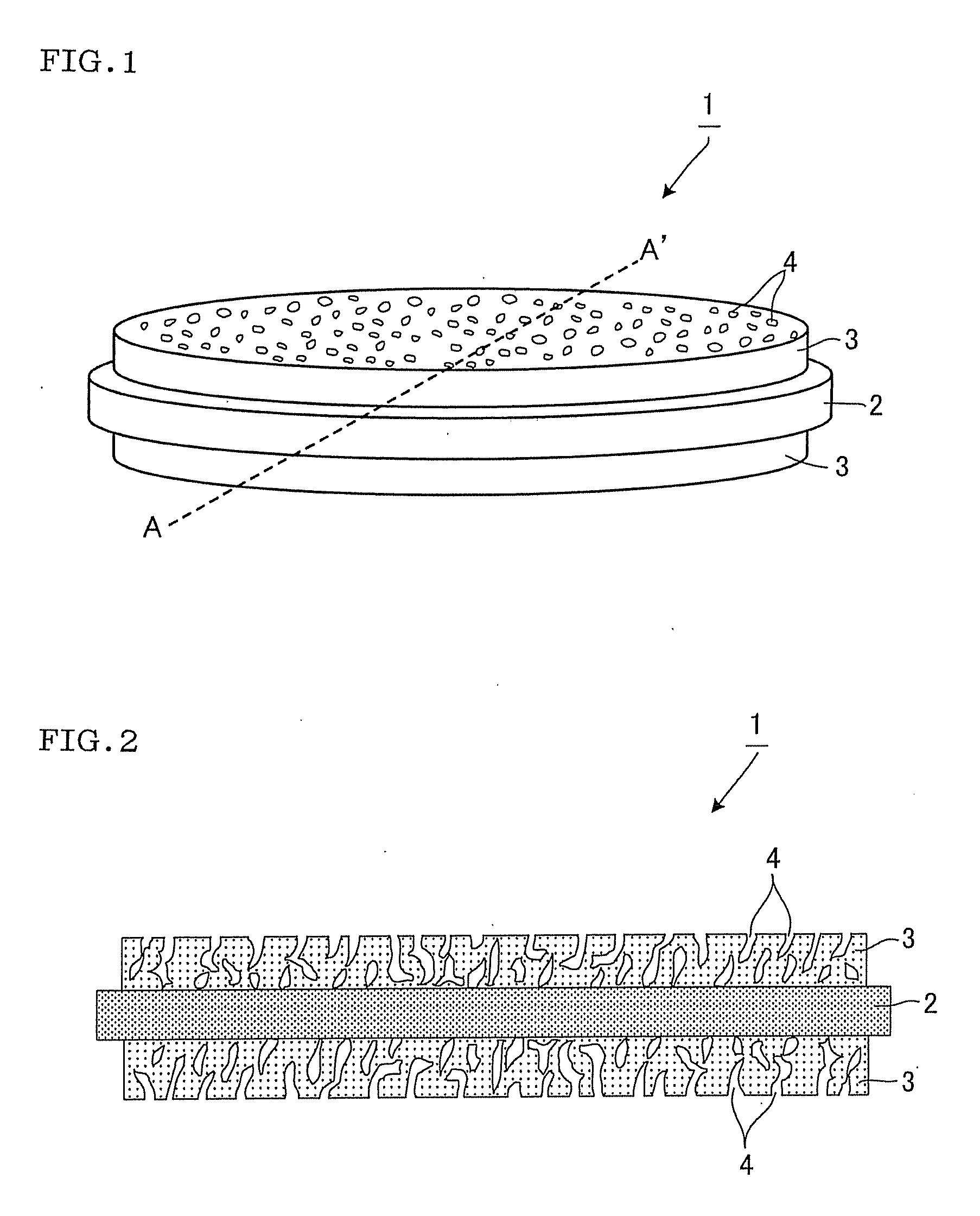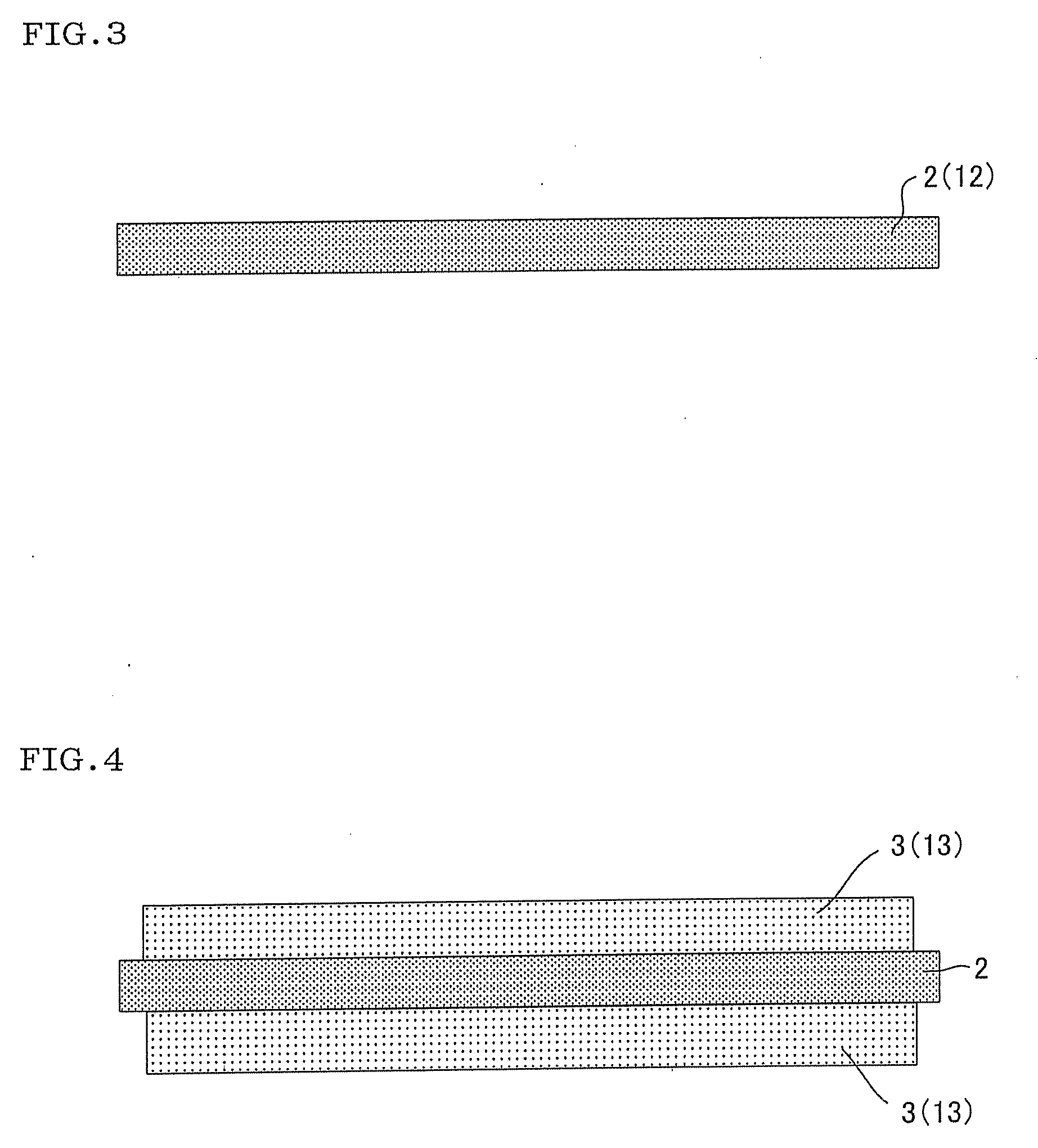Solid electrolyte structure for all-solid-state battery, all-solid-state battery, and their production methods
a technology of solid electrolyte and all-solid-state batteries, which is applied in the field of solid electrolyte structure for all-solid-state batteries and all-solid-state batteries, can solve the problems of insufficient contact area (necking), inability to obtain excellent charge/discharge characteristics, and inability to reduce contact resistance (grain boundary resistance) at the interface, etc., to achieve easy and inexpensive production, excellent charge/discharge characteristics, and reduce contact resistance
- Summary
- Abstract
- Description
- Claims
- Application Information
AI Technical Summary
Benefits of technology
Problems solved by technology
Method used
Image
Examples
example 1
[0093]An Li0.35La0.55TiO3 (solid electrolyte) powder (first ceramic material) was formed with a press-mold to obtain a first formed body having a diameter of about 13 mm and a thickness of 1 mm (dimensions after firing). The first formed body was fired at 1150° C. in air to obtain a dense body.
[0094]A screen printing paste (second ceramic material) was prepared using a solid electrolyte powder having the same composition as that of the solid electrolyte used for the first formed body. In this example, S-LEC B (manufactured by Sekisui Chemical Co., Ltd.) (binder), CS-12 (manufactured by Chisso Corporation) (organic solvent), and theobromine (pore-forming agent) were added to the solid electrolyte powder when preparing the screen printing paste corresponding to the design of pores formed in a porous layer. The screen printing paste was applied to the surface of the dense body by a screen printing method to obtain a second formed body having a diameter of about 12 mm and a thickness of...
example 2
[0101]An all-solid-state battery (Example 2) was produced in the same manner as in Example 1, except that the screen printing paste (second ceramic material) used to form the porous layer of the solid electrolyte structure was prepared using the solid electrolyte powder, S-LEC B (manufactured by Sekisui Chemical Co., Ltd.) (binder), and CS-12 (manufactured by Chisso Corporation) (organic solvent) so that the porous layer had a porosity lower than that of the porous layer of Example 1 and the pore size of the pores was smaller than that of the porous layer of Example 1. FIG. 8 shows an SEM photograph of the cross section of the dense body 2 and the porous layer 3 of the solid electrolyte structure 1 produced in Example 2.
example 3
[0102]An Li1.5Al0.5Ge1.5(PO4)3 (solid electrolyte) powder (first ceramic material) was formed with a press-mold to obtain a first formed body having a diameter of about 13 mm and a thickness of 1 mm (dimensions after firing). The first formed body was fired at 840° C. in air to obtain a dense body.
[0103]A screen printing paste (second ceramic material) was prepared using a solid electrolyte powder having the same composition as that of the solid electrolyte used for the first formed body. In this example, S-LEC B (manufactured by Sekisui Chemical Co., Ltd.) (binder), CS-12 (manufactured by Chisso Corporation) (organic solvent), and theobromine (pore-forming agent) were added to the solid electrolyte powder when preparing the screen printing paste corresponding to the design of pores formed in a porous layer. The screen printing paste was applied to the surface of the dense body by a screen printing method to obtain a second formed body having a diameter of about 12 mm and a thicknes...
PUM
| Property | Measurement | Unit |
|---|---|---|
| thickness | aaaaa | aaaaa |
| thickness | aaaaa | aaaaa |
| thickness | aaaaa | aaaaa |
Abstract
Description
Claims
Application Information
 Login to View More
Login to View More - R&D
- Intellectual Property
- Life Sciences
- Materials
- Tech Scout
- Unparalleled Data Quality
- Higher Quality Content
- 60% Fewer Hallucinations
Browse by: Latest US Patents, China's latest patents, Technical Efficacy Thesaurus, Application Domain, Technology Topic, Popular Technical Reports.
© 2025 PatSnap. All rights reserved.Legal|Privacy policy|Modern Slavery Act Transparency Statement|Sitemap|About US| Contact US: help@patsnap.com



